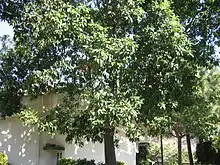Elaeocarpus ganitrus
Elaeocarpus ganitrus, is a large evergreen broad-leaved tree whose seed is traditionally used for prayer beads in Hinduism. The seeds are known as rudraksha, or rudraksh, Sanskrit: rudrākṣa ("Rudra's teardrops"). Rudraksha may be produced by several species of Elaeocarpus, however E. ganitrus is the principal species used in the making of mala.
| Elaeocarpus ganitrus | |
|---|---|
 | |
| Scientific classification | |
| Kingdom: | Plantae |
| Clade: | Tracheophytes |
| Clade: | Angiosperms |
| Clade: | Eudicots |
| Clade: | Rosids |
| Order: | Oxalidales |
| Family: | Elaeocarpaceae |
| Genus: | Elaeocarpus |
| Species: | E. ganitrus |
| Binomial name | |
| Elaeocarpus ganitrus | |
Description
Elaeocarpus ganitrus grows in the area from the Gangetic plain in the foothills of the Himalayas to South-East Asia, Indonesia, New Guinea, Guam, and Hawaii.[2] Rudraksha seeds are covered by an outer husk of blue colour when fully ripe, and for this reason are also known as blueberry beads. The blue colour is not derived from pigment but is structural.[3] It is an evergreen tree that grows quickly. The rudraksha tree starts bearing fruit in three to four years. As the tree matures, the roots buttress rising up narrowly near the trunk and radiating out along the surface of the ground.
Taxonomy and naming
Elaeocarpus ganitrus was first formally described in 1831 by George Don in A General History of the Dichlamydeous Plants from an unpublished description by William Roxburgh.[1][4]
It is regarded as a synonym of Elaeocarpus angustifolius by Plants of the World Online where its distribution is given as 'Himalaya to China (Yunnan, Guangxi) and SW. Pacific", but the Australian Plant Census considers E. angustifolius as being endemic to the Northern Territory.[1][5] Rudraksha is a Sanskrit compound consisting of the name Rudra ("Shiva") and akṣha ("teardrops").[6][7] The specific epithet ganitrus is derived from ganitri, the name for this species in Sundanese and Malay.
Chemical constituents
Chemical constituents present in E. ganitrus are elaeocarpidine, isoelaeocarpine, epiisoelaeocarpiline, rudrakine, flavonoids, quercetin, phytosterols, fat, alkaloids, carbohydrates, ethanol, proteins, tannins, gallic acid and ellagic acid.[8]
Gallery
 Elaeocarpus ganitrus fruit on the tree
Elaeocarpus ganitrus fruit on the tree Elaeocarpus ganitrus fruit and leaves
Elaeocarpus ganitrus fruit and leaves Ripe Rudraksh fruit freshly plucked
Ripe Rudraksh fruit freshly plucked Dried seeds of Rudraksh
Dried seeds of Rudraksh
References
- "Elaeocarpus ganitrus". Plants of the World Online. Retrieved 4 February 2021.
- Koul, M. K. (2001-05-13). "Bond with the beads". Spectrum. India: The Tribune.
- Lee, D. W. (1991). "Ultrastructural Basis and Function of Iridescent Blue Color of Fruits in Elaeocarpus". Nature. 349 (6306): 260–262. doi:10.1038/349260a0. S2CID 13332325.
- Don, George (1831). A General History of the Dichlamydeous Plants. 1. London: J.G. and F. Rivington. p. 559. Retrieved 4 February 2021.
- "Elaeocarpus angustifolius". Australian Plant Census. Retrieved 4 February 2021.
- The translation of rudrākṣa as "Rudra's teardrops" and definition as berries of Elaeocarpus ganitrus see: Stutley, p. 119.
- Stutley, M. (1985). The Illustrated Dictionary of Hindu Iconography. New Delhi, India: Munshiram Manoharlal Publishers. ISBN 81-215-1087-2.
- https://www.researchgate.net/profile/Navin_Kumar23/publication/236107802_A_comprehensive_report_on_therapeutic_potential_of_Elaeocarpus_ganitrus_Roxb._(Rudraksha)/links/0deec515fae789097b000000.pdf